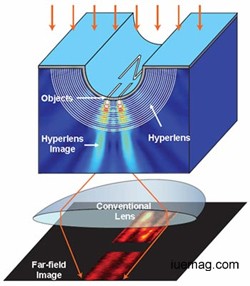

Science Pick
A collection of write-ups that speak for what's trending in science & technology.

Ad
Meta Material - Playing with Electro Magnetic Radiations

Introduction:
Invisibility has been employed in works of science fiction and fantasy, from “cloaking devices” on spaceships in the various Star Trek series to Harry Potter’s magic cloak. These concepts seemed to be unnatural and ideal. But, the time has changed!!We have Meta Materials.
Metamaterials are man-made composites, its precise shape, geometry, size, orientation and arrangement can affect waves of light (electromagnetic radiation) or sound in a manner not observed in natural materials.
The idea behind metamaterials is to mimic the way atoms interact with light, but with artificial structures much smaller than the wavelength of light itself. This way, optical properties are no longer restricted to those of the constituent materials, and can be designed almost arbitrarily.

Applications:
Defence:
Construct satellite trackers that never need to move. Similar technology could serve as portable, energy-efficient satellite communication units for soldiers on the battlefield.
Cloaking Devices: (Controlling EMF)
Bend light to effectively create an invisibility cloak. This works exactly like it sounds which is what's so impressive.
So how do metamaterials make something appear invisible?
Defence:
Construct satellite trackers that never need to move. Similar technology could serve as portable, energy-efficient satellite communication units for soldiers on the battlefield.
Cloaking Devices: (Controlling EMF)
Bend light to effectively create an invisibility cloak. This works exactly like it sounds which is what's so impressive.
So how do metamaterials make something appear invisible?

Imagine a fabric woven of thread. In this fabric, light is only allowed to flow over the threads (meaning it can't travel into the nooks and crannies between the threads). If you punch a hole in the fabric with a pin, light will go around the hole and resume its original course of travel since light can only travel over the thread. So, to the light waves, the hole doesn't exist. If you put an object in the hole, the light waves would go around the object too, effectively rendering the object invisible.

Super Lens:
The diffraction limit is an inherent limitation in conventional optical devices or lenses. The lens of a camera or microscope is incapable of capturing some very fine details of any given image. The super lens, on the other hand, is intended to capture these fine details.
Consequently, conventional lens limitation has inhibited progress in certain areas of the biological sciences. This is because a virus or DNA molecule is out of visual range with the highest powered microscopes. Also, this limitation inhibits seeing the minute processes of cellular proteins moving alongside microtubules of a living cell in their natural environments.
Metamaterial Fiber Communication:
Metamaterial fibers could guide light and plasmons, surface energy waves induced by photons. They do what optical fibers do, but much faster, speeding telecommunications and making for faster sensors.
The Meta Material goes Digital:
The researchers of the Nature Materials paper, from the University of Pennsylvania, were inspired to develop digital metamaterials by the binary numeral system of Boolean algebra. The binary system is used internally by most digital electronic devices, such as computers and smartphones. Complex digital devices have their digital information simply encoded as a string of 1s and 0s called “bits”. The proposed method for digital metamaterials is a simplified way of building metamaterials, yet still allows for complex and diverse properties to be achieved.
Limitations:
It only works for a limited range of wavelengths. The way metamaterials function is through electromagnetic properties of a material (its permittivity and permeability). These need to take specific value at each position in the metamaterials grid for the device to work.
For a given functionality, you cannot change the shape of a metamaterial during operation. The design of a metamaterial strongly connects electromagnetic properties to a fixed relative position in space. If you stretch and bend a metamaterial, it wouldn’t work in the same way anymore.
Metamaterials are tiny structures fabricated with high precision. Metamaterials are made on the Nano scale with high precision. As I said, they need to be smaller than the wavelength of light. This means for visible light we are talking about individual elements not much larger than the tiny transistor on your computer Processor. Making them on a large scale (people, cars, space ships) would be really difficult. Nevertheless, people have recently made metamaterials structures on plastic substrates, which is encouraging.
Conclusion:
In my view, there are many applications of metamaterials. Most will not be very glamorous. Perhaps they will have a very specific use or won’t operate for visible light, in the infrared instead, or at radiofrequencies. Nevertheless, metamaterials have a lot to contribute to science and technology. And if we are better aware of their advantages as well as disadvantages, we may get a more realistic idea in what areas metamaterials could deliver the best.
The diffraction limit is an inherent limitation in conventional optical devices or lenses. The lens of a camera or microscope is incapable of capturing some very fine details of any given image. The super lens, on the other hand, is intended to capture these fine details.
Consequently, conventional lens limitation has inhibited progress in certain areas of the biological sciences. This is because a virus or DNA molecule is out of visual range with the highest powered microscopes. Also, this limitation inhibits seeing the minute processes of cellular proteins moving alongside microtubules of a living cell in their natural environments.
Metamaterial Fiber Communication:
Metamaterial fibers could guide light and plasmons, surface energy waves induced by photons. They do what optical fibers do, but much faster, speeding telecommunications and making for faster sensors.
The Meta Material goes Digital:
The researchers of the Nature Materials paper, from the University of Pennsylvania, were inspired to develop digital metamaterials by the binary numeral system of Boolean algebra. The binary system is used internally by most digital electronic devices, such as computers and smartphones. Complex digital devices have their digital information simply encoded as a string of 1s and 0s called “bits”. The proposed method for digital metamaterials is a simplified way of building metamaterials, yet still allows for complex and diverse properties to be achieved.
Limitations:
It only works for a limited range of wavelengths. The way metamaterials function is through electromagnetic properties of a material (its permittivity and permeability). These need to take specific value at each position in the metamaterials grid for the device to work.
For a given functionality, you cannot change the shape of a metamaterial during operation. The design of a metamaterial strongly connects electromagnetic properties to a fixed relative position in space. If you stretch and bend a metamaterial, it wouldn’t work in the same way anymore.
Metamaterials are tiny structures fabricated with high precision. Metamaterials are made on the Nano scale with high precision. As I said, they need to be smaller than the wavelength of light. This means for visible light we are talking about individual elements not much larger than the tiny transistor on your computer Processor. Making them on a large scale (people, cars, space ships) would be really difficult. Nevertheless, people have recently made metamaterials structures on plastic substrates, which is encouraging.
Conclusion:
In my view, there are many applications of metamaterials. Most will not be very glamorous. Perhaps they will have a very specific use or won’t operate for visible light, in the infrared instead, or at radiofrequencies. Nevertheless, metamaterials have a lot to contribute to science and technology. And if we are better aware of their advantages as well as disadvantages, we may get a more realistic idea in what areas metamaterials could deliver the best.
Get the Latest & Recommended articles in your Inbox
Sources- Ball, Phillip. "TR10: Invisible revolution." Technology Review. March 12, 2007. http://www.technologyreview.com/Nanotech/18292/
- Cauchi, Stephen. "Behold the ultimate predator - the invisible army." The Age. November 11, 2007. http://www.theage.com.au/news/national/behold-the-ultimate-predator--the-invisible-army/2007/11/10/1194329568834.html
- http://en.wikipedia.org/wiki/Metamaterial
Copyrights © 2024 Inspiration Unlimited eMagazine
Any facts, figures or references stated here are made by the author & don't reflect the endorsement of iU at all times unless otherwise drafted by official staff at iU. This article was first published here on 15th December 2014.



